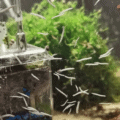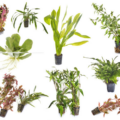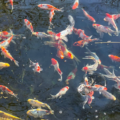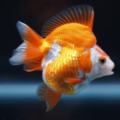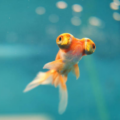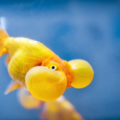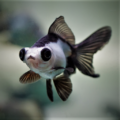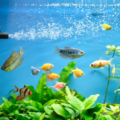This comprehensive care guide for Common Goldfish teaches you everything you need for proper breeding techniques, tank setups, feeding, and much more!
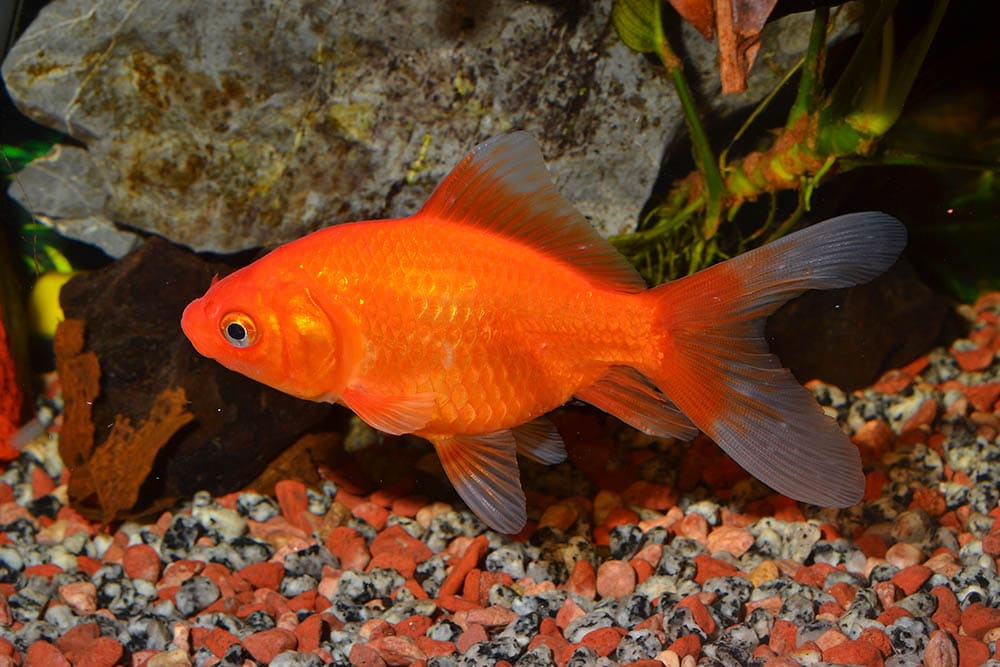
Introduction
Many fancy Goldfish breeds exist today through selective breeding. The common Goldfish is a popular first for many fish hobbyists due to its popularity which also makes its orange/reddish-gold color widely recognizable. This is the most Common Goldfish appearance, which has earned it quite the reputation in the aquatic realm.
Thanks to their highly social nature, goldfish were the first captive-bred fish species to dominate the aquatic hobbyist world. With proper care, the average goldfish can grow into a large freshwater fish, reaching about 12 inches in aquariums and larger in ponds while maintaining its highly captivating beauty.
Fun Fact: The color patterns on multicolored goldfish may change throughout its lifespan.
Other endearing physical features include their streamlined bodies and forked tails. Common Goldfish also showcase natural hardiness in their ability to adapt to various temperatures and grow larger depending on the tank or pond size.
Dig into our care guide to help you get started on your common Goldfish collecting journey.
Tank or Pond Requirements

The ideal tank or pond setup for Common Goldfish is one that would satisfy their need for ample space and contain an excellent water filtration system. While Common Goldfish can thrive in contained tanks, they’re best suited for larger spaces, such as ponds, where they can grow to their full size.
Common Goldfish are naturally a cold-water fish but can tolerate a wide temperature range at warmer degrees, but they need stable water quality to survive and grow.
Tank Size: The recommended Common Goldfish tank size should have about 20 gallons of water per fish; if the fish are larger, you can increase your quota to 50-100 gallons.
Pond Size: Common Goldfish thrive in large ponds where they have ample space to grow to any length. Pond care for goldfish includes installing a good filtration system to help remove small particles that may affect water quality.
Water Parameters: Your prospective pets are very cold water friendly. This means Goldfish water conditions are best kept clean with a stable pH level between 7 and 8.4 and proper oxygenation through regular water aeration to maintain optimum oxygen levels within their artificial habitats.
Without proper water parameters maintained, the tank’s water quality can degrade, which can cause a wide range of issues from cloudy aquarium water to illness and mass fish die off. So remember, maintaining stable water parameters is crucial to a Common Goldfish’s survival and reproduction process.
Feeding Common Goldfish

Common Goldfish are fast feeders and predominantly omnivores who can also consume sinking pellets. These pellets are great protein sources for them, representing about 30% of their diet. Sinking pellets prevent excessive air consumption during eating, which may cause the fish to bloat.
- Preferred Food: In addition to pellets, the best food for Common Goldfish includes live or frozen shrimp, blood worms, krill, daphnia, and vegetables like romaine lettuce, spinach, and cabbage.
- Frequency: Feeding goldfish can be a bit tricky, however necessary. This is because the chances of overfeeding are very high, which may lead to your fish producing more waste than necessary. Now, how do you prevent that? It is advised to maintain a feeding frequency of 2-3 times daily in small amounts. This will also ensure water quality stays premium.
- Nutritional Needs: A balanced Common Goldfish diet that contains both protein and plant matter helps with the overall health and coloration of the Common Goldfish.
For more on feeding your aquatic pets check out The Ultimate Guide to Fish Food: Pros and Cons & Best Choices!
Side Note: Common Goldfish usually require more carbohydrates than other freshwater fish.
Lifespan of Common Goldfish

The longevity of Common Goldfish is largely dependant on many factors like clean water for them to live and stay active, a balanced diet to supply them with all the nutrients needed to ensure growth and ample space for ease of movement and breeding.
- Lifespan Range: The Common Goldfish’ lifespan can range from 10 to 30 years and can be extended as pets when kept in excellent conditions. Extending the lifespan of any fish requires great commitment and sticking by the set rules unless you risk losing them to diseases and poor water quality.
Breeding Common Goldfish
Common Goldfish can reproduce in tanks and ponds if the conditions are optimal. Breeding Common Goldfish begins during the late Spring and Summer months, with the male chasing the female to produce eggs on surfaces or plants.
The spawning environment should contain plants and roots to help trap the stray eggs so the male fish can locate them for fertilization. You can also get a spawning mop for the egg-catching process.
Author’s Note: For some planted tank decor tips check out our article on The 8 Best Live Plants for Goldfish Aquariums, there are indeed live plants that can thrive in a goldfish habitat!
These fish can also be induced to begin spawning behavior at any time of the year. The water temperature should be kept between 68-74°F to mimic seasonal changes and kickstart the natural reproduction process (provide the fishes with a higher supply of protein and fat to prepare them for the spawning season).
After spawning, it is best to remove the eggs to prevent the parents from feeding on them. Moving the eggs to a separate tank is the perfect idea.
Goldfish Fry Care
The fertilized eggs hatch a few days after the spawning process has ended. At this point, maintaining premium water quality AT ALL TIMES is essential to the fry’s survival.
A regular feeding schedule should also be introduced. Once the fry is about an inch long, separation to a larger tank/pond should begin to provide ample space to thrive.
Common Health Issues

The following are Common Goldfish health issues and how to treat them.
Fin Rot
- Causes: Poor water quality and fungal infection due to overcrowding.
- Symptoms: Decaying fins, redness at the base of the fins
- Solution: Fix water quality through regular testing and water changes. Aquarium salt can be added to a tank or pond as first aid, and then an expert can be consulted for more intensive treatment.
Swim Bladder Disorder
- Causes: Overfeeding or constipation from air-filled pellets, as well as poor water quality.
- Symptoms: Floating upside down, difficulty in maintaining swimming pattern
- Solution: Introduce sinking pellets to your goldfish’s diet so they don’t have to come to the surface for food, and space feeding frequency to allow proper digestion between meals.
Parasitic Infection
- Causes: Infected fishes in tanks/ponds, external parasites like ich, flukes, poor water quality.
- Symptoms: White spots on the body, inflammation on the scale, labored breathing
- Solution: Improve water quality and quarantine affected fish to prevent spread. Use copper-based medications to treat ich.
For more details checkout our article on How to Treat Ich Outbreaks in Your Freshwater Fish!
Preventing Diseases In Common Goldfish
- Perform regular water changes to eliminate harmful toxins, as Common Goldfish produce significantly more waste than any other aquarium fish.
- Monitor your goldfish closely to detect early signs of illness to ensure quick treatment; early quarantine is also advised.
- Keep a close eye on water parameters for water temperature and pH level changes that may harm your goldfish’s health.
- Providing a balanced diet rich in carbohydrates and protein can prevent diseases such as fish rot and swim bladder disorder in goldfish.
Tank Mates for Common Goldfish
Goldfish are a friendly bunch that co-exists peacefully with other fish species, meaning they can be housed with other cold-water fish similarly sized in a Goldfish community tank – think Comet Goldfish or Shubunkins.
See Also: 15 Types of Goldfish for Your Aquarium
Compatible Fish: Common Goldfish make great tank mates with other types of goldfish, weather loaches, or white cloud minnows; add some freshwater varieties like guppies, plecos, and catfish in there for a more inclusive tank.
Aside from the apparent freshwater fish compatibility, the good thing about these options is that they’re also non-aggressive aquatic pets, so they won’t compete with the goldfish for food or resources.
Incompatible Fish: Don’t get carried away by their peaceful nature, some fishes don’t mix well with Common Goldfish. Avoid mixing tropical fish or fish that require warmer water, as you won’t need to use a heater with goldfish except during breeding season.
Community Tank: Keeping your goldfish with tank mates that require similar care requirements is a great way to create a balanced community and ensure longevity for every member of the tank.
See also: How Many Goldfish Should Be Kept Together?
Now that we’re clear on Common Goldfish tank mates, the next agenda is how to create a safe home for them
Common Goldfish in Ponds

Setting up an outdoor pond is one of the best things you can do for your Common Goldfish they are valid reasons as to why. These fish thrive in larger spaces with ample natural sunlight and cooler water temperatures.
A good pond filtration system is necessary for any pond to get rid of excess waste. You can use a canister filter if your pond is a very large one, otherwise, a sponge filter would do great work if you’re looking for multiple smaller filters.
See Also: What Type Of Filter Is Best For A Fish Tank?
Pond Setup: The general rule of thumb when building ponds for goldfish is to make 5 gallons per 1 inch of an adult goldfish’s length. This means that a minimum of 500 gallons or more will work more perfectly for the health of the average goldfish.
The pond depth can be around 3 feet or deeper to encourage temperature regulation during cold seasons and aid quality oxygenation needed to keep goldfish healthy and active.
Pond Maintenance: Regular pond cleaning to get rid of waste and routine water testing should be done at least once a week to monitor pH level, ammonia level, and nitrate level. Water circulation in the pond should be slow to mimic water currents and provide high oxygen levels usually found in the fish’s natural habitat.
Seasonal Care: Common Goldfish are quite tolerant animals and can withstand colder temperatures typical during winter (a testament to their impeccable range) because they readily adjust their metabolism in response to any temperature drop, making them less active.
How do I carry out Common Goldfish pond care when the cold comes knocking? We’ve got you.
- Due to the fall in temperature during winter, you can introduce a pond heater to keep things warm; but never exceed 64-75°F in water temperature.
- Reduce feeding frequency during colder seasons as their metabolism slows down during winter, and overfeeding can lead to water quality depletion.
- Keep a close eye on nitrate and ammonia levels during winter and carry out regular water changes.
- Introduce artificial hiding spots such as rocks and plants to protect them from the cold and serve as resting points.
Conclusion
Here’s a rundown of all the details in this freshwater fish maintenance guide.
Common Goldfish’s long lifespan and high adaptability to various tank and pond setups have earned them a place on the list of the most collected fish in the world. These pond beauties are totally beginner fish care friendly, which means with a little experience and a bit of learning, anyone can keep them, also, you have over 3 decades to learn on the job.
Use these Common Goldfish care tips curated for you in this very helpful guide and begin your blissful journey of keeping healthy and thriving fish only!

